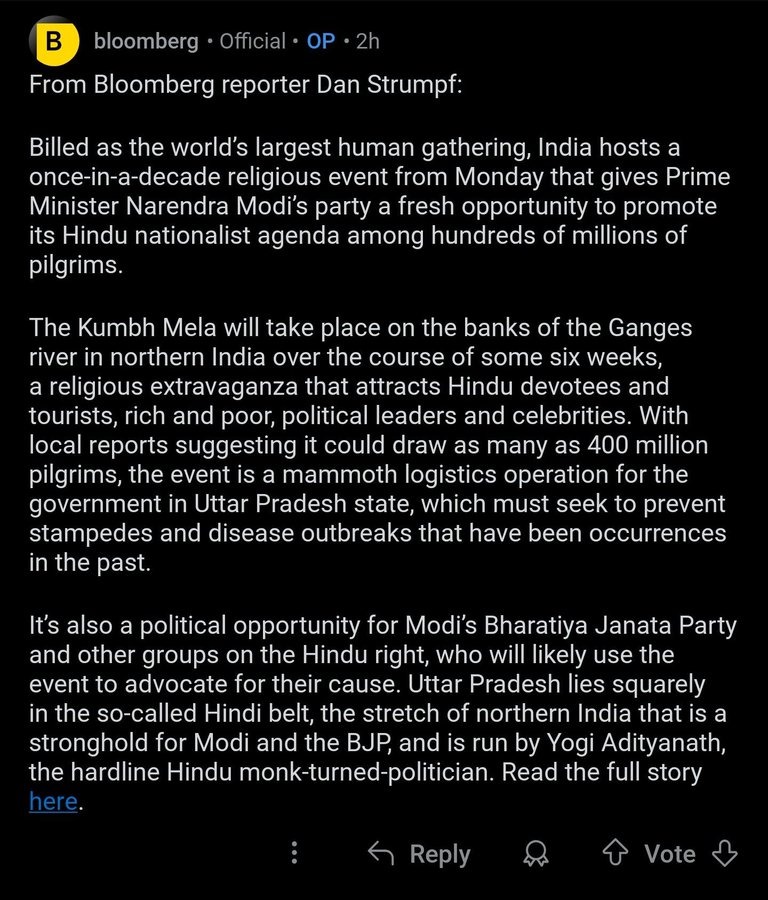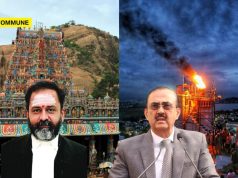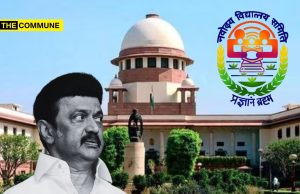
The 45-day Maha Kumbh Mela 2025, heralded as the largest gathering on Earth, began early Monday with the observance of Paush Purnima. An estimated 15 million devotees are anticipated to take a holy dip at the Sangam, the sacred confluence of the Ganga, Yamuna, and the mythical Saraswati, all while being surrounded by robust security arrangements.
However, in a baffling display of cultural insensitivity and thinly veiled bias as well as severe meltdown, Bloomberg’s coverage of the Maha Kumbh Mela 2025 reads more like a rant against India’s rich traditions than a balanced report on the world’s largest gathering. While the event attracts millions of devotees, creating an awe-inspiring testament to faith, logistics, and human resilience, Bloomberg seems intent on reducing it to a political weapon wielded by the ruling party.
Ignoring The Essence Of The Kumbh
The Maha Kumbh Mela, held every 12 years, is not just a religious event but a global spectacle of devotion, culture, and humanity. It represents a confluence of spirituality and tradition, uniting millions across diverse backgrounds. Yet, Bloomberg chose to focus disproportionately on alleged political motivations and administrative shortcomings, brushing aside the event’s profound cultural and spiritual significance.
Rather than celebrating the mammoth efforts behind organizing such an event — a temporary city spread across 10,000 acres with infrastructure rivaling permanent urban centers — the report fixates on political narratives, sowing division where unity is being celebrated.
The “Hindu Nationalist” Alarm Bell
Bloomberg’s favorite buzzword, “Hindu nationalist,” is wielded with reckless abandon. The report frames every aspect of the Kumbh Mela as a calculated move by Prime Minister Narendra Modi’s government to push a political agenda. The rich traditions of the event, rooted in millennia of history, are almost entirely overshadowed by insinuations about vote-bank politics and “Hindu right” posturing.

This reductionist narrative is not just unfair; it’s lazy journalism. The Maha Kumbh Mela has been a cornerstone of Hindu spirituality for centuries, predating modern political ideologies by millennia. To suggest that its grandeur and significance are mere tools for political gain is an insult to the millions of devotees who gather in faith.
Infrastructure Marvel? Not Worth Mentioning, Apparently
While Bloomberg begrudgingly acknowledges the logistical effort — temporary bridges, hospitals, roads, sanitation for millions, and AI-enabled technology for crowd management — the tone drips with condescension. The very challenges the report harps on, such as sanitation and public health, are being met with innovative solutions like 150,000 toilets, AI-driven crowd surveillance, and waste management technologies. Yet, the achievements are dismissed or overshadowed by doom-laden predictions of disaster.
Politicizing Faith
Bloomberg claims the event is a platform for the BJP to push its agenda, citing the renaming of Allahabad to Prayagraj and opposition to non-Hindu food vendors. These claims, while dramatic, ignore the broader context. Renaming Prayagraj was part of a larger effort to restore historical and cultural identities, not a sinister plot. Similarly, the focus on certain controversies overrules the reality of a festival that remains inclusive and welcoming to millions, regardless of faith or nationality.
Stoking Fear Instead Of Appreciating Arrangements
The paragraph, “One big challenge looms over the event — dealing with the sheer volume of human waste generated by such a gathering. The Ganges is already known for its heavy pollution levels, and past festivals have turned into a breeding ground for disease due to inadequate waste-disposal measures. Officials have said 150,000 toilets have been dispatched to the event, while technology from India’s space and nuclear research agencies is reportedly being deployed to help cope with the volumes of sewage. Prior events haven’t been without mishaps and disasters. Deadly stampedes have occurred on numerous occasions: In 1954, a stampede resulting in the death of large numbers of pilgrims on the event’s main bathing day, while a 2013 stampede at a train station killed dozens. Public health experts said the 2021 Kumbh Mela became a “super spreader” event for Covid-19.“, reeks of bias and comparing events that happened in the past.
The 1954 UP government was led by Dr Sampoornanand of the Indian National Congress, and Akhilesh Yadav of the Samajwadi Party led the 2013 government.
Bloomberg’s portrayal of the challenges faced by the Maha Kumbh Mela reeks of sensationalism designed to instill fear rather than provide balanced reporting. While managing human waste and ensuring public safety are undoubtedly significant tasks for any event of this magnitude, the report blows these issues out of proportion, painting an overly grim picture. The mention of past mishaps and disasters, some dating back decades, serves no purpose other than to amplify a narrative of chaos. It conveniently ignores the strides made in logistics, technology, and sanitation, such as deploying cutting-edge systems and an unprecedented number of toilets to handle waste effectively. Instead of acknowledging the government’s proactive measures, Bloomberg appears to stoke anxiety and cast doubt on the event’s success.
A Global Celebration, Not A “Political Circus”
Bloomberg fails to acknowledge the people in power while comparing to earlier “mishaps“. It unnecessarily compares 2013-era ads to the present. “The 2013 Kumbh Mela was an advertising bonanza, with brands finding creative ways to pitch their products to Indians on tight budgets, with cheap glasses of Coca-Cola for sale alongside rotis stamped with advertisements for soap.” Sentences like these reek of ignorance.
It also says, “Indian advertising agency Shreyas Media, which won advertising rights for the event, said it expects Indian companies to spend 30 billion rupees ($349 million) at the Kumbh Mela. The company said it’s selling advertising to companies on billboards, charging stations, sky balloons, and other platforms.”
Yes, the Kumbh Mela is a revenue generator for the government, and why not? The 2019 Kumbh generated ₹1.2 lakh crore as revenue for the state government, while the 2013 one generated ₹12,000 crore. And what is wrong with that?
The Maha Kumbh Mela is not merely an Indian event; it is a global phenomenon. Pilgrims from all walks of life — rich and poor, Indian and international — come together for an unparalleled spiritual experience. It is a testament to the resilience of human faith and the power of collective effort. By failing to recognize this, Bloomberg reveals its inability to see beyond narrow political lenses.
Bloomberg’s coverage of the Maha Kumbh Mela 2025 is a stark reminder of the pitfalls of parachute journalism. Instead of celebrating the event’s scale, faith, and logistical brilliance, it opts for a reductive, politically charged narrative that disrespects the millions who hold the Kumbh sacred.
Perhaps Bloomberg should take a step back, dip into the sacred waters of the Sangam, and cleanse its reporting of bias and cynicism. The Maha Kumbh Mela deserves better than being a pawn in the publication’s agenda-driven storytelling.
Subscribe to our channels on Telegram, WhatsApp, and Instagram and get the best stories of the day delivered to you personally.




